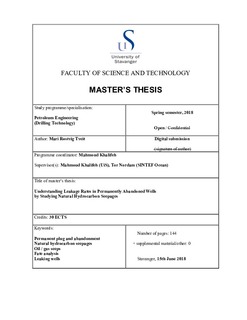| dc.contributor.advisor | Khalifeh, Mahmoud | |
| dc.contributor.author | Tveit, Mari Røstvig | |
| dc.date.accessioned | 2018-10-10T12:23:58Z | |
| dc.date.available | 2018-10-10T12:23:58Z | |
| dc.date.issued | 2018-06 | |
| dc.identifier.uri | http://hdl.handle.net/11250/2567449 | |
| dc.description | Master's thesis in Petroleum engineering. | nb_NO |
| dc.description.abstract | Permanent plug and abandonment (PP&A) of wells is steadily becoming more important on the Norwegian Continental Shelf (NCS), as a large number of fields are approaching end of their productive life. Combining operational, material, and qualification challenges, it is evident that risk of leaks exists from permanently abandoned wells. To ensure the protection of our environment, well integrity standard NORSOK D-010 constitutes zero leak acceptance criteria; however, natural hydrocarbon seepages are occurring all over the world on a daily basis. To evaluate the fate of leaking oil and/or gas from abandoned wells, two real cases from the NCS, one historical gas leak (Field A) and one theoretical oil leak (Field B), have been subject to fate analysis, executed using software from SINTEF Ocean’s Marine Environmental Modeling Workbench (MEMW). For Field A, it is found that approximately 95 to 99% of the leaking gas dissolves while rising through the water column. The fraction of gas transported to atmosphere is a function of the initial gas bubble size and ambient temperature. The fate of oil is more complex than gas, but results show that due to its persistent nature, released oil will be able to travel more than hundred kilometers away from the release point. Due to this dispersion, concentrations, the main factor controlling toxicity, will be greatly diluted. Fate of oil is dependent on chemical composition; lighter compounds will evaporate to the atmosphere, while heavy compounds will be deposited on the seafloor. Evaporation, sedimentation and biodegradation are the main contributing mechanisms in fate analysis of oil. | nb_NO |
| dc.language.iso | eng | nb_NO |
| dc.publisher | University of Stavanger, Norway | nb_NO |
| dc.relation.ispartofseries | Masteroppgave/UIS-TN-IEP/2018; | |
| dc.rights | Navngivelse-Ikkekommersiell 4.0 Internasjonal | * |
| dc.rights.uri | http://creativecommons.org/licenses/by-nc/4.0/deed.no | * |
| dc.subject | petroleumsteknologi | nb_NO |
| dc.subject | petroleum engineering | nb_NO |
| dc.subject | permanent plug and abandonment | nb_NO |
| dc.subject | natural hydrocarbon seepages | nb_NO |
| dc.subject | oil / gas seeps | nb_NO |
| dc.subject | p&a | nb_NO |
| dc.subject | leaking wells | nb_NO |
| dc.subject | boreteknologi | nb_NO |
| dc.subject | fate analysis | nb_NO |
| dc.title | Understanding Leakage Rates in Permanently Abandoned Wells by Studying Natural Hydrocarbon Seepages | nb_NO |
| dc.type | Master thesis | nb_NO |
| dc.subject.nsi | VDP::Teknologi: 500::Berg‑ og petroleumsfag: 510::Petroleumsteknologi: 512 | nb_NO |

